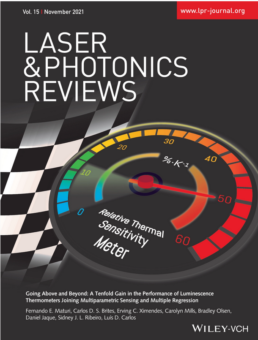Going Above and Beyond: A Tenfold Gain in the Performance of Luminescence Thermometers Joining Multiparametric Sensing and Multiple Regression
Category : Publications | Date : Août 21, 2021
Fernando E. Maturi, Carlos D. S. Brites, Erving C. Ximendes, Carolyn Mills, Bradley Olsen, Daniel Jaque, Sidney J. L. Ribeiro, Luís D. Carlos
Laser & Photonics Reviews 2021, 2100301
Luminescence thermometry has substantially progressed in the last decade, rapidly approaching the performance of concurrent technologies. Performance is usually assessed through the relative thermal sensitivity, Sr, and temperature uncertainty, δT. Until now, the state-of-the-art values at ambient conditions do not exceed maximum Sr of 12.5% K−1 and minimum δT of 0.1 K. Although these numbers are satisfactory for most applications, they are insufficient for fields that require lower thermal uncertainties, such as biomedicine. This has motivated the development of materials with an improved thermal response, many of them responding to the temperature through distinct photophysical properties. This paper demonstrates how the performance of multiparametric luminescent thermometers can be further improved by simply applying new analysis routes. The synergy between multiparametric readouts and multiple linear regression makes possible a tenfold improvement in Sr and δT, reaching a world record of 50% K−1 and 0.05 K, respectively. This is achieved without requiring the development of new materials or upgrading the detection system as illustrated by using the green fluorescent protein and Ag2S nanoparticles. These results open a new era in biomedicine thanks to the development of new diagnosis tools based on the detection of super-small temperature fluctuations in living specimens.
